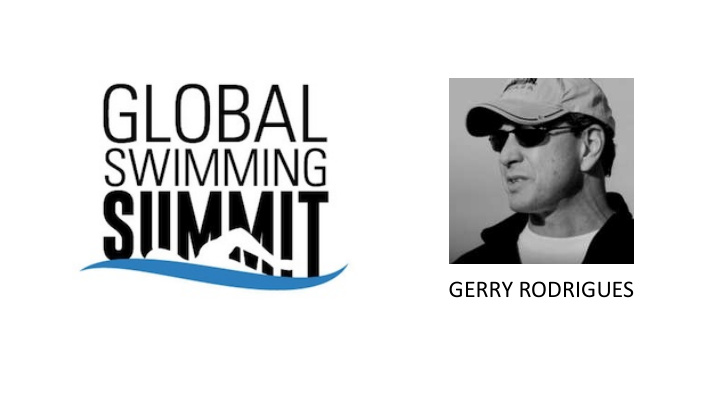



GERRY RODRIGUES
Gerry Rodrigues • Tower 26 Club • www.tower26.com • 100% Triathletes • Coaching Triathletes for 30 Years
Technique • Differences between swimmers and triathletes • Key Question: What is stopping a person from improving? • Focuses for mechanics: • Good Structural Presence • Alignment • Propulsion
Structural Presence • Maintain form in a suspended/weightless state • New swimmers are rigid out of fear. • The body is the framework for all mechanics • First piece to go as an athlete fatigues • Training • Vertical Kicking • Kicking with Snorkel • Aim to minimize torso rocking while kicking
Always FAST Swimming! • Fast=tighter frame • Short and fast swimming assists in teaching structure.
Alignment • Focus on hands, as they guide alignment. • Establish a center line and minimize crossover with hands. • Hand must stay between center line and line off of the same side shoulder. • Head must stay aligned with spine. • Minimize head tilt
Propulsion • Propulsion does not exist without the first two points. • Requires firm hands underwater • Gentile hands=slow • Firm hands=powerful
Coaching Cues • Talk simply but with intent • Use analogies • Remember your audience • Swimming for exercise? • Triathlete? • Competitive swimmer?
New Swimmer Frustration • Usually get too much information when learning technique • Taught to kick hard • Heightened heart rate • Not much propulsion • Quick frustration for new swimmer • The key points are all the age group swimmer needs to make big improvement.
Swimming for Triathletes • Training protocol is dictated by race and athlete goals for that race • Beginner: • “Recreation can be a subset of competition but competition can not be a subset of recreation.” • Teach based on what the athlete wants to achieve. • Look at the question of “time.” • Swimming is a small portion of the overall triathlon. • Feel for the water is developed by more frequency with water • Swim 4x40 minutes a week instead of 2x1:20 a week
We are land animals! • Water movement patterns do not occur regularly on land. • The key is to build comfort with the water. • Swimming frequently does not have to mean long duration practices. • Everything comes back to the athlete’s goals.
Training Mistakes • Swimming continuously instead of mixing in intervals • Swim coaches are looking at races that last four minutes or less. • Triathletes need to be aware of this when understanding principles of swimming. • Lack of consideration for variables that occur in triathlon
Open Water Training • Build a foundation into the pool first. • Safety is critical for open water swimming. • Practice sighting, muscular endurance, etc. in the pool first. • Add in open water closer to race. • The pool offers a better environment for learning skills and progressing. • Add open water sessions during race season for familiarity and comfort. • Establish pool standards for an athlete before they enter open water. • Be able to swim two minutes per 100 • 35-minute mile
Practices • Swim sets can be recycled with a different purpose • 10x400 steady pace early in the year • 10x400 during the season • Dive in entry • Swim first 100 fast (breakout in open water race) • Sight 2-3x every 25 • Swim last 100 fast • Climb out of pool at end and jog in place for 10 seconds • Same set with a different focus • Progression does not have to be complex!
Open Water Swimming: 3 F’s • Fear • Open water elicits fear response • Frequency • Repetition • Familiarity • Comfort with water and skill
Want to contact Gerry? • www.tower26.com
Recommend
More recommend